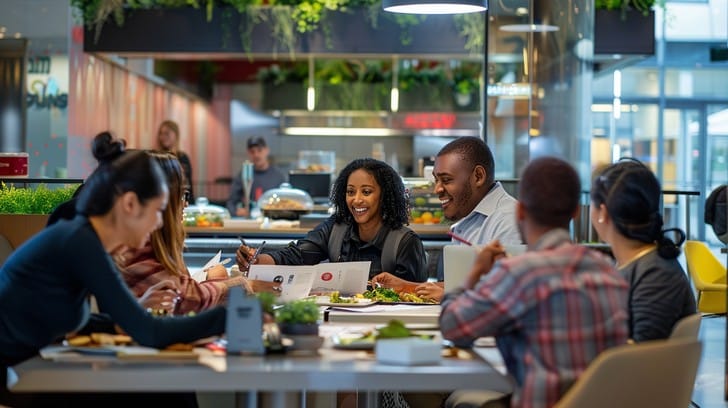Workplace cafeterias and its impact on wellbeing

“To me, food is as much about the moment, the occasion, the location and the company as it is about the taste.” - Heston Blumenthal
We know that consistent and nutritious meals are a big part of having a healthy lifestyle. But quotes like the above and “family that eats together stays together” show us that food or meal times are about more than just what goes into our stomachs.
Remember break times in school when you might have shared your tiffin with others, or waited to find out what they brought? The social aspects of food also contribute to our experience of consuming food and make it something to look forward to, beyond simply sustaining the body. This highlights the role that workplace cafeterias can play, and how food and environment contribute to a healthier workplace
Consider the cafeteria as an alternate space to work with casual collaboration! This can transform the use of the area, and either offer an additional workspace for those seeking a change of environment or present those who typically eat alone at their desks the opportunity to meet others.
How can having an in-house cafeteria help your organization?
Here are some of how a cafeteria within the office premises can be helpful:
- Promotes interaction and familiarity across the organization: A study published in the Journal of Occupational Health Psychology points out that employees who have a regular opportunity to interact with colleagues in informal settings experience increased levels of social support and job satisfaction. Interaction across departments can lead to better team cohesion.
- Cost-effectiveness: It’s more efficient and convenient for employees to be within the office premises, as it increases their actual time for eating with less travel/prep time at home. It helps employees stick to work hours while ensuring their health is also taken care of.
- Health benefits in the long run: On-site food arrangements help employees maintain a healthy lifestyle by giving them the option of regular meals. Consuming nutritious meals and working on a satisfied stomach can reduce the risk of chronic diseases and improve energy levels, contributing to overall job satisfaction and reduced absenteeism.
- Incentive for new employees: Research in Human Resource Management Review shows that amenities that enhance convenience contribute to overall job satisfaction and work-life balance.
- The incentive for working from the office: Having the option for tasty meals increases the likelihood of local employees coming in to work as it helps sort out meal arrangements.
How can your in-house cafeteria be an effective one?
- Options for healthy eating: The International Journal of Workplace Health Management indicates that access to healthy food at work is associated with improved employee health and productivity. Cafeterias that offer nutritious food options positively impact employee health and wellbeing.
- The ability to be used all day and through the week - Cafeteria or food services must be made available to employees for the duration of their work day and through the entire work week. Offering meals only at certain times of the week may lead to employees losing interest as they have to make arrangements for their meals for the remaining days.
- Access to natural light and greenery: Incorporating natural light and greenery into cafeteria design has been shown to improve mood and reduce stress, as indicated in research published in Building and Environment. A space that feels airy and open is naturally welcoming.
- Make it an environment-friendly place: Making environmentally-friendly decisions makes an impact towards a sustainable future, and invites employees to make lifestyle changes. Using reusable cutlery (steel spoons, plates and glasses), avoid the use of straws or keep steel ones.
- Offer variety and subsidised costs - Offering simple, fresh food at an appropriate cost is more useful than highly-priced luxury items. Further, some variety in dishes can cater to different dietary needs and preferences, enhancing satisfaction and choice.
- Co-create the space - Take feedback from employees about how they would like the space to be, use artwork made by employees, have a dishwashing station to build responsibility and accountability for employees and reduce the load of hospitality staff.
- You can also have a Cafeteria Committee! This is a group of employees who can be middle persons between employees, organisation management and cafeteria management, and provide informal feedback.
- Feedback Mechanisms: Take regular feedback to adjust offerings, especially in case of any logistical / service changes. Also, conduct surveys to track cafeteria usage and analyse health-related outcomes as well as changes in employee engagement to assess the cafeteria's impact.
FAQs
Does a cafeteria influence employee morale?
Yes! A well-thought-out cafeteria can boost employee morale by giving a pleasant environment for interactions, relaxation, taking breaks, and consuming meals, whether they are bought or made at home. It offers a sense of community and belonging among employees from across the organisation.
What are some downsides to workplace cafeterias?
The cost and maintenance of setting up a kitchen and staff or coordinating between vendors can be a big initial downside. Maintaining quality and hygiene of food and ensuring enough choices to result in adequate usage of facilities is also important to factor in.



